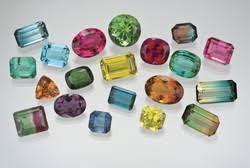What is a Tourmaline Gem Stone?
Tourmaline is a crystalline boron silicate mineral compounded with elements such as aluminium, iron, magnesium, sodium, lithium, or potassium. Tourmaline is classified as a semi-precious stone and the gemstone comes in a wide variety of colours. The name comes from the Sinhalese word "Thoramalli or "tōra- molli", which is applied to a group of gemstones found in Sri Lanka.
It is believed that the first tourmalines were discovered by conquistadors in Brazil in the 1500s. At the time, these green tourmalines were assumed to be emeralds. It wasn’t until the 1800s when scientists realized that these stones were their own species of mineral.

Large deposits of tourmaline have been found in Maine and California. They were extremely popular stones in China, who would eagerly buy up American tourmaline specimens for jewellery and sculptures. Until 1912, the American tourmaline trade was booming. At that time, the Chinese government collapsed and the demand for the stones plummeted. The trade would pick back up when discoveries of deposits in countries like Brazil, Afghanistan, and Madagascar renewed interest in these multi-coloured gemstones.
Tourmaline has a variety of colours. Usually, iron-rich tourmalines are black to bluish-black to deep brown, while magnesium-rich varieties are brown to yellow, and lithium-rich tourmalines are almost any colour: blue, green, red, yellow, pink, etc. Bi-coloured and multi-coloured crystals are common, reflecting variations of fluid chemistry during crystallization. Crystals may be green at one end and pink at the other, or green on the outside and pink inside; this type is called watermelon tourmaline. Some forms of tourmaline are dichroic, in that they change colour when viewed from different directions.

Tourmaline is the traditional birthstone for October, the stone for the zodiac sign of Leo and the accepted gem for the 8th wedding anniversary.






